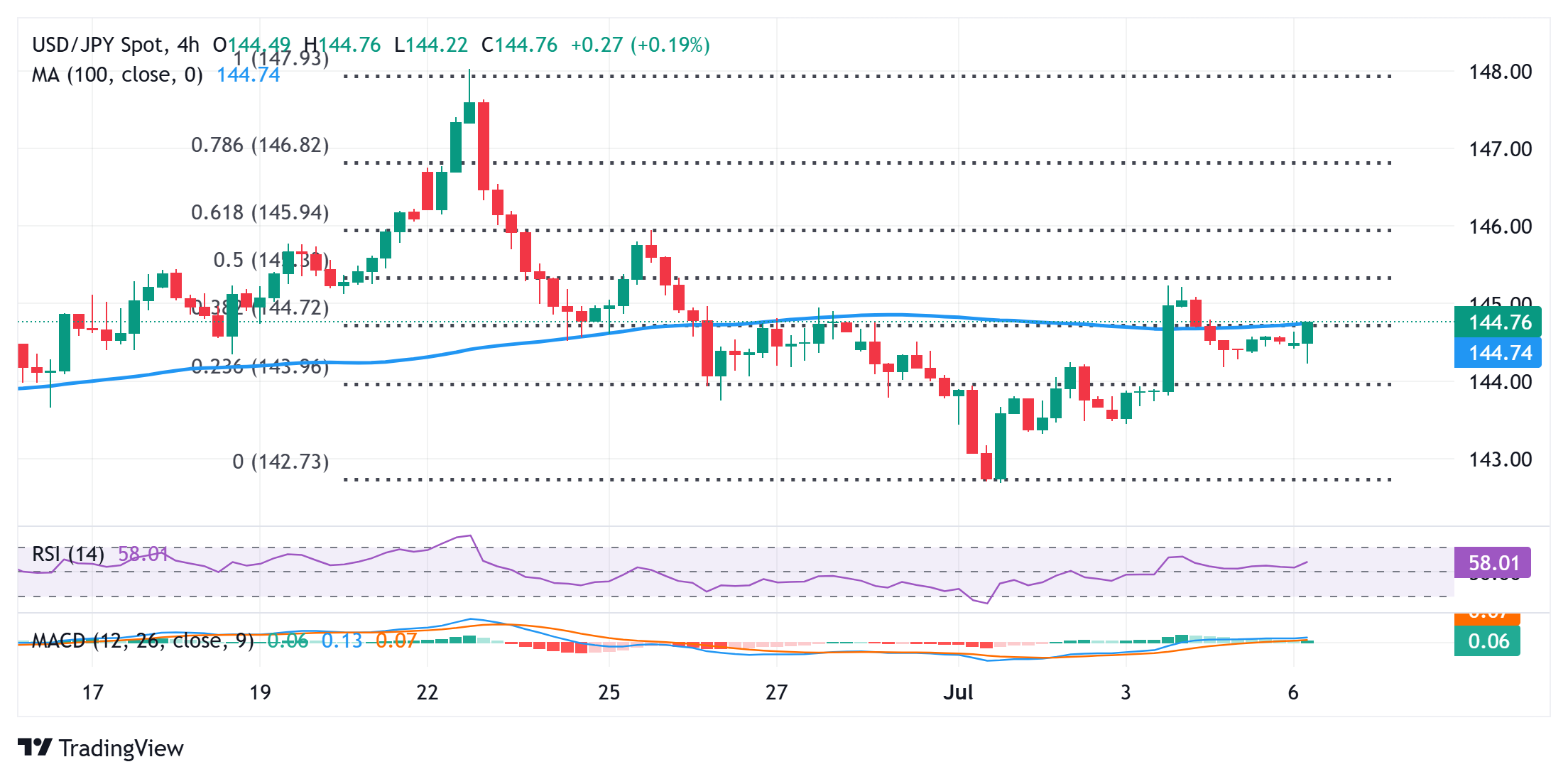Japanese Yen weakens as dismal wage growth data tempers early BoJ rate hike bets
- The Japanese Yen drifts lower in reaction to weaker domestic wage growth data.
- Geopolitical risks and divergent BoJ-Fed expectations should limit JPY losses.
- The USD bearish sentiment might further contribute to capping the USD/JPY pair.
The Japanese Yen (JPY) edges lower against its American counterpart at the start of a new week following the release of weaker domestic data. Real wages in Japan fell for the fifth straight month in May, at the fastest pace in nearly two years amid persistent inflationary pressures. This comes on top of the looming US tariffs on Japanese exports, which could squeeze corporate profits and potentially undermine future wage growth. The outlook could complicate the BoJ’s monetary policy normalization schedule and act as a headwind for the JPY.
Meanwhile, Israeli strikes on three Yemeni ports early this Monday keep geopolitical risks in play and should benefit the JPY's relative safe-haven status. Moreover, the growing acceptance that the BoJ will hike interest rates again might hold back the JPY bears from placing aggressive bets. In contrast, the US Dollar (USD) bulls remain on the sidelines amid bets that the Federal Reserve (Fed) would resume its rate-cutting cycle in the near future. This, in turn, should contribute to capping the upside for the USD/JPY pair amid the absence of relevant macro data.
Japanese Yen attracts some sellers as Japan’s real wages fall the most in nearly two years
- The Israeli military carried out intense strikes on Houthi targets in three Yemeni ports and a power plant early this Monday in response to repeated attacks by the Iran-aligned group on Israel. This marks the first Israeli attack on Yemen in almost a month and should drive safe-haven flows towards the Japanese Yen.
- Government data released earlier today showed that Nominal Wages in Japan rose 1% in May 2025 from a year earlier, marking the third straight month of deceleration and falling well short of market expectations. This was also the weakest growth since March 2024 amid an 18.7% plunge in special bonus payments.
- Adding to this, inflation-adjusted real wages posted the steepest decline in 20 months and fell 2.9% YoY in May compared to a revised 2.0% drop in the previous month. Meanwhile, the consumer inflation rate that the labour ministry uses to calculate real wages climbed 4.0% YoY during the reported month.
- The data fueled concerns that stagnant real incomes could dampen consumer spending and stall broader economic recovery amid heightened uncertainty over US President Donald Trump's new tariffs. This might complicate the Bank of Japan’s path to normalising interest rates and capping gains for the JPY.
- The US Dollar, on the other hand, struggles to register any meaningful recovery from a multi-year low touched last week amid relatively dovish Federal Reserve expectations. In fact, traders are pricing in over a 70% chance of a rate cut in September and at least two 25 basis points rate reductions this year.
- Investors now look forward to the release of the FOMC meeting minutes on Wednesday for fresh cues about the Fed's policy outlook and rate-cut path. This, in turn, will play a key role in influencing the near-term USD price dynamics and providing some meaningful impetus to the USD/JPY pair.
USD/JPY could accelerate the positive move above the 144.65-144.70 confluence

Momentum beyond the 144.65-144.70 confluence – comprising the 100-period Simple Moving Average (SMA) on the 4-hour chart and the 38.2% Fibonacci retracement level of the June-July downfall – would be seen as a key trigger for the USD/JPY bulls. The subsequent move up could allow spot prices to reclaim the 145.00 psychological mark and test the 145.25-145.30 supply zone. A sustained strength beyond the latter should pave the way towards the 61.8% Fibo. retracement level, around the 146.00 round figure.
On the flip side, the Asian session low, around the 144.20 horizontal zone, could offer some support ahead of the 144.00 round figure, or the 23.6% Fibo. retracement level. A convincing break below might shift the bias back in favor of bearish traders and drag the USD/JPY pair to the 143.45 intermediate support en route to the 143.00 mark. The downward trajectory could extend further towards the 142.70-142.65 region, or a one-month low touched last Tuesday.
Economic Indicator
Labor Cash Earnings (YoY)
This indicator, released by the Ministry of Health, Labor and Welfare, shows the average income, before taxes, per regular employee. It includes overtime pay and bonuses but it doesn't take into account earnings from holding financial assets nor capital gains. Higher income puts upward pressures on consumption, and is inflationary for the Japanese economy. Generally, a higher-than-expected reading is bullish for the Japanese Yen (JPY), while a below-the-market consensus result is bearish.
Read more.Last release: Sun Jul 06, 2025 23:30
Frequency: Monthly
Actual: 1%
Consensus: 2.4%
Previous: 2.3%
Source: Ministry of Economy, Trade and Industry of Japan

